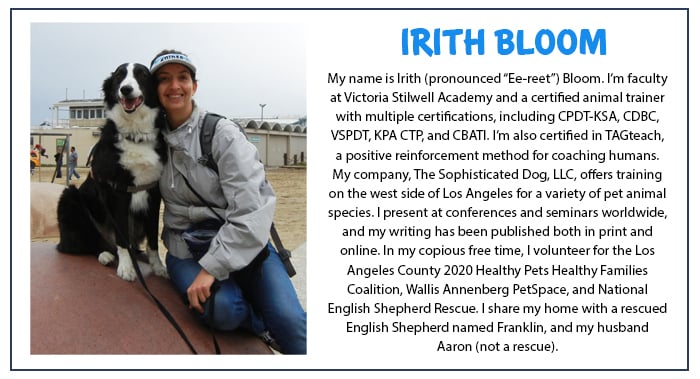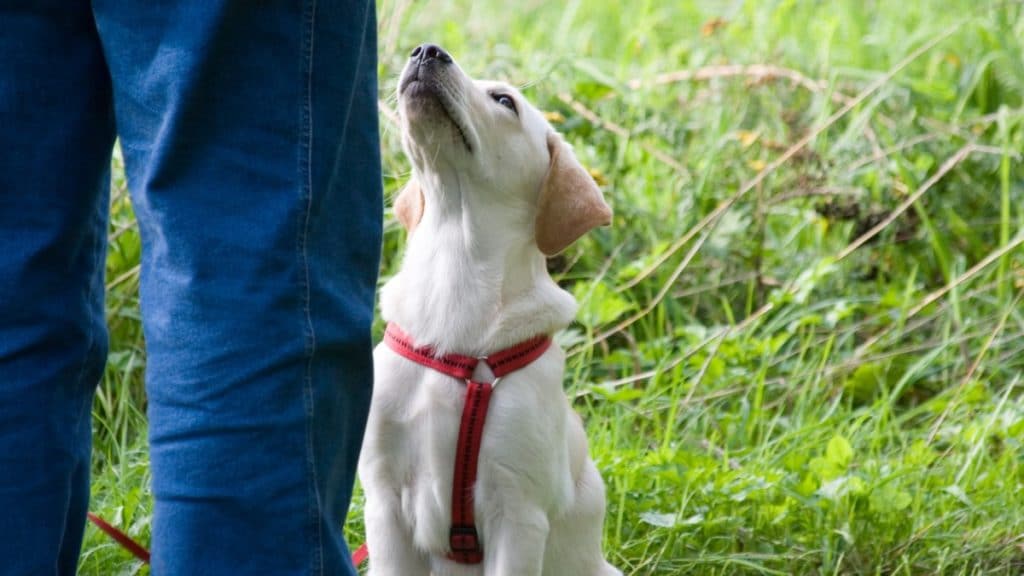Clicker training and behavior chains are a hot topic in dog training nowadays. In “Teaching Your Dog to Perform Behavior Chains,” we learned a “behavior chain” is when an animal performs more than one behavior before earning positive reinforcement.
For example, instead of my dog sitting on cue and then getting a treat, he would sit, lie down and spin to earn the treat. You can see this method also helps reduce the amount of food given during dog behavior training.
There are two types of behavior chains: behavior chains with handler cues, which we focused on in the last article, and fixed behavior chains. We’ll focus on fixed behavior chains now.
What Are Fixed Behavior Chains?
Behavior chains are fixed when the sequence of behaviors is the same each time. They include dog behaviors such as retrieving an object, in which the handler gives a single cue at the beginning (“Fetch”), and the animal does the entire series of required behaviors without any other cues from the handler.
Say you want to train your dog to retrieve a toy and put it in a box. This is actually a chain of behaviors. Your dog must find the toy, pick it up, carry it to the box and drop it in.
If your dog has difficulty with any of the individual behaviors, he won’t be able to do the behavior chain properly. The key to successfully teaching a fixed dog behavior chain is to first make sure your dog understands each of the individual behaviors.
How to Teach a Fixed Dog Behavior Chain
You’ll need a clicker, like Starmark’s pro-training clicker, and dog training treats, like Pet Botanics’ training rewards. And remember, you’ll need to train your dog to do all of the individual behaviors before teaching them as a behavior chain.
Once your dog can do each task individually on cue, you can start to train the dog behavior chain. The best way to do this is through “backchaining.”
In backchaining, you start with the last step in the chain and slowly build backwards to the first step. Backchaining is effective because it ensures your dog always moves toward well-practiced behaviors with a strong history of reinforcement. In other words, your dog is comfortable throughout the behavior chain because he always knows what’s coming next.
Let’s look at how backchaining works when teaching your dog to retrieve an item and drop it in a toy box, for example.
Use “Backchaining” to Teach Your Dog All the Steps in a Fixed Behavior Chain
When training your dog a behavior chain of retrieving something, like a Multipet Lamb Chop plush toy, and puttting it in a box, here’s what the finished behavior should look like:
- You have a cue, like “Lambie in toy box.”
- Dog finds the toy.
- Dog picks up the toy.
- Dog carries the toy to the box.
- Dog drops the toy into the box.
- You click and feed your dog a treat.
To backchain, you start with steps five and six, which are dropping the toy into the box to earn a click and a treat.
First, cue your pup to grab the toy from you while he stands right over the box. (NOTE: If you’re having issues with your dog grabbing the toy, you’ll need to train that behavior separately and give it a cue, such a “take it.”)
Once your dog picks up the toy, start backchaining by cueing “drop it.” Once your dog drops the toy into the box, click and treat. Repeat steps five and six many times, so the dog is really jazzed about dropping the toy into the box to earn the click and treat.
Now it’s time to add the previous step, which is carrying the toy to the box. Assuming you practiced steps five and six many times, your pup should be eager to get to the box to drop the toy.
This makes teaching step four as simple as placing the toy on the floor near to the box, cueing your dog to take it and then waiting for him to poke his nose over the rim of the box before you cue “drop it.” You might not even need to cue “bring the toy to the box.”
Gradually place the toy further away from the box before cueing “take it,” so your dog must take more steps toward the box with the toy. If he drops the toy too early, go back to a closer distance and build up again more slowly.
Once your dog will carry the toy across the room to the box, start to ask him to stay while you walk away and place the toy on the floor. Then release your dog and cue him to pick up the toy, which he’ll probably grab and drop in the box since that’s earned him so many clicks and treats.
You also can throw the toy while your dog stays at your side, and then cue him to go get the toy. If he won’t walk over to get the toy when it’s far away, go back to a distance he can handle and build up again more slowly.
Add the Dog Behavior Chain Cue
Once your dog will get the toy from basically anywhere and drop it in the box, you can add your dog behavior chain cue. To do this, say “Put Lambie in toy box” (or your cue of choice) before placing or tossing the toy a little ways away. Then use your cues for “go to toy,” “pick up toy” “bring toy” and “drop toy.” Give the cue for the next behavior right when you would click if you were practicing just that behavior, but don’t actually click for each individual behavior. Click and treat only for the final behavior—dropping the toy into the box.
Dogs are great at learning patterns. Since this fixed dog behavior chain’s pattern is the same each time, your dog will quickly learn to anticipate your cues.
You can begin to leave out individual behavior cues as soon as you notice your pup is starting the next behavior before you even give the cue for it. Soon “Put Lambie in toy box” will be the only cue you need, and you and your dog will be having a lot of fun.

Featured Image: via iStock.com/Lios
Share:












